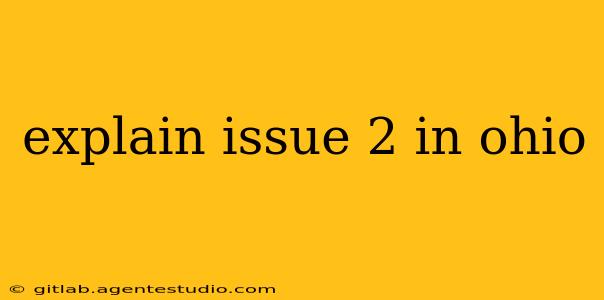Understanding Ohio Issue 2: A Deep Dive into the August 8th Special Election
Ohio Issue 2, which appeared on the August 8th, 2023, special election ballot, significantly altered the process for amending the Ohio Constitution. Understanding its implications requires examining its core provisions and the broader context of its controversial passage.
What Issue 2 Proposed:
Issue 2, officially titled the "Citizens' Right to Make Laws," aimed to raise the threshold for passing future constitutional amendments. Instead of a simple majority (50% + 1 vote), it proposed requiring a 60% supermajority for any constitutional amendment to pass. This change applied to all future amendments, not just those passed after the election.
The Controversy Surrounding Issue 2:
The primary reason for Issue 2's contentious nature lies in its timing. It was placed on the ballot just weeks before a November ballot initiative (Issue 1) that would enshrine abortion rights in the Ohio Constitution. Many viewed Issue 2 as a direct attempt to make it significantly harder, if not impossible, for Issue 1 to pass. This perception fueled accusations of partisan maneuvering and an attempt to circumvent the will of the people.
Arguments For Issue 2:
Supporters argued that raising the threshold for constitutional amendments would make the process more difficult, thereby protecting the Constitution from impulsive or poorly considered changes. They claimed that the current system is too easily manipulated by special interest groups and that a higher threshold would ensure greater deliberation and public consensus before making significant changes to the fundamental law of the state.
Arguments Against Issue 2:
Opponents argued that Issue 2 was a blatant power grab, designed to stifle the voices of Ohioans and prevent them from directly participating in shaping their state's future. They highlighted that a 60% threshold sets an unusually high bar, making it considerably more challenging for citizens to initiate and pass amendments reflecting their priorities. The perception of it as a partisan tactic further fueled opposition.
The Outcome of Issue 2:
Ohio voters overwhelmingly rejected Issue 2, demonstrating a clear preference for maintaining the existing amendment process. This outcome suggests a strong belief in the right of citizens to directly influence their state's constitution through a more accessible process.
Long-Term Implications:
While Issue 2 failed, its impact on Ohio politics is undeniable. It exposed deep divisions within the state over the role of direct democracy and the appropriate level of difficulty in amending the state's constitution. The debate surrounding Issue 2 will likely continue to shape future political discourse and strategies in Ohio. It highlighted concerns regarding potential future attempts to manipulate the amendment process for partisan advantage.
Understanding the broader context: The failure of Issue 2 also highlights the growing importance of understanding citizen-led ballot initiatives and their implications. Researching the arguments both for and against these initiatives is crucial for informed civic participation. Understanding the motivations behind such proposals is key to navigating the complexities of state-level politics.

